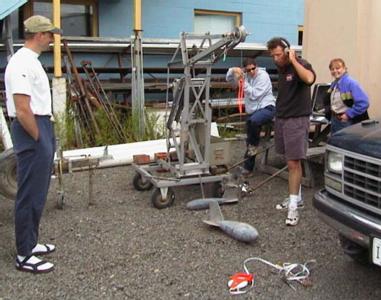
|
|
9 July, 1999
July 9
Today we met the "stream team". They consist of Christy Swindling,
undergraduate student from University of California at Santa Cruz (UCSC),
Erin Kraal, graduate student at UCSC, and Robert Anderson, professor of
Earth Science at UCSC. Their task will be to monitor the discharge of the
glacial stream (the Kennicott River) as it emerges from the base of the
glacier at McCarthy. This will become parcticularly exciting for them when
Hidden Creek Lake (located 12 miles up valley from the snout) breaks out and
drains from beneath the glacier. When the lake drains, the discharge of the
stream increases from a trickle to a raging torrent in a matter of minutes.
They will be collecting discharge data by using a stream gauge which will be
lowered from a bridge which spans the Kennicott River. Collecting this
measurement will further enhance an understanding of the hydraulic
connection between the subglacial and terminal stream channel(s?), and will
help in understanding the geomorphic changes to the stream channel during
the flood.
This morning we (the UCSC stream team, PSU Principal Investigator Andrew
Fountain, PSU grad student Don Lindsay, and myself) picked up the stream
gauge from the United States Geological Survey (USGS) field office in
Anchorage. They will be loaning it to the project for the summer. We were
also given a lesson on its use. The first step when using a stream gauge is
to lower a water flow current meter to a position which is 60 percent of
total stream depth from the surface of the stream. For example, a stream
with a depth of 10 meters would need to have a current meter positioned at a
depth of 6 meters. This depth provides the most characteristic "average"
for the velocity at that cross sectional position of the stream. A current
meter consists of a propeller-like device which spins in the stream at a
rate which is dependant upon the velocity of the flow. The current meter is
attached to a heavy, torpedo-shaped object with tail fins which stabilizes
the position and orientation of the current meter. As the propeller spins
in the water, it sends back an impulse every 5 revolutions via an electrical
cable. These impulses are counted for a given period of time, from which
the velocity of the stream at that point can be determined. In knowing the
depth of the stream, and in taking a series of these measurements across the
width of the stream, the discharge can be calculated. Of course, when the
lake breaks out and the stream reaches flood stage, it is expected that ice
chunks will be bobbing their way down the stream, and boulders will be
moving along the bottom. Hopefully the stream gauge will survive the
potential bombardment of unseen debris.
One of the chief interests of the stream team is to characterize how the
stream channel will change during the flood. This is both scientifically
interesting and will also provide for future hazard assessment of the
stream. Any prediction of how the stream erodes during the glacial outburst
flood will help minimize potential loss of life and property in the future.
_______________________________________________________________
Get Free Email and Do More On The Web. Visit http://www.msn.com

The stream team, becoming familiar with the stream gauge - also known as the "finger catcher". From left to right is PSU grad student Don Lindsay, UCSC undergrad student Christy Swindling, UCSC geomorphologist Bob Anderson (with headset), and UCSC grad student Erin Kraal.
Contact the TEA in the field at
.
If you cannot connect through your browser, copy the
TEA's e-mail address in the "To:" line of
your favorite e-mail package.
|
